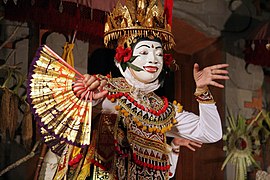
Balinese dance
Balinese dance (Indonesian: tarian Bali; Balinese: ᬇᬕᭂᬮᬦ᭄ᬩᬮᬶ (igelan Bali)) is an ancient dance tradition that is part of the religious and artistic expression among the Balinese people of Bali island, Indonesia. Balinese dance is dynamic, angular, and intensely expressive.[1] Balinese dancers express the stories of dance-drama through bodily gestures including gestures of fingers, hands, head, and eyes.
Three Genres of Traditional Dance in Bali
Oral traditions and expressions, including language as a vehicle of the intangible cultural heritage, performing arts, social practices, rituals and festive events, knowledge and practices concerning nature and the universe, and traditional craftsmanship
2015 (10th session)
Representative List
There is a great richness of dance forms and styles in Bali; and particularly notable are those ritualistic dance dramas which involve Rangda, the witch, and the great beast Barong. Most of the dances in Bali are connected to Hindu or traditional folk rituals, such as the Sanghyang Dedari sacred dance that invokes benevolent hyang spirits, believed to possess the dancers in a trance state during the performance. Other Balinese dances are not linked to religious rituals and are created for certain occasions or purposes, such as the Baris or Pendet welcoming dances and Joged dance, which is a social dance for entertainment.
In Bali there are various categories of dance,[7] including epic performances such as the omnipresent Mahabharata[8] and Ramayana.
Certain ceremonies at village temples feature a special performance of a dance-drama, a battle between the mythical characters Rangda, the witch representing evil, and Barong, the lion or dragon, representing good. This type of performance was traditionally featured during outbreaks of epidemic diseases which were believed by the people to be a result of a disturbance in the balance of the 'good and bad forces', which were represented by the Rangda and the Barong. The battle usually reconciles in harmony or balance of the Rangda and the Barong, instead of a defeat of the evil.
Among the dance traditions in Bali are:
Traditionally, sacred dances can only be performed in temples. However, new choreographies have been created due to the demand from tourists. One example, Tari Sekar Jagat (Tari means dance in the Balinese language), is a relatively new choreography that has become popular. In the newer creations, choreographers have more freedom over the moves. They used new moves that were considered 'improper' for the sacred dances. For example, in Tari Sekar Jagat, there is a movement when the dancers hold the Dulang below their shoulders. This ceremonial pedestal, which may be wooden or ceramic, is normally held high following its sacredness. Below shoulder level but above the navel represents an ordinary or everyday state.[9]
Bali dancers learn the craft as children, they play Balinese music. They are taught to dance with their hands before they can walk. Official training as a Bali dancer starts as young as 7. In Balinese dance, the movement is closely associated with the rhythms produced by the gamelan, a musical ensemble specific to Java and Bali.[10] Multiple levels of articulations in the face, eyes, hands, arms, hips, and feet are coordinated to reflect layers of percussive sounds.
The number of codified hand positions and gestures, the mudras,[11][12][13] is higher in India than in Java or Bali. It has been speculated that they have been forgotten as the dance was transmitted from India to Java.[14] Hand positions and gestures are nonetheless as important in Javanese and Balinese dance as in India.[15] Whether in India, Indonesia, or Cambodia, hands have a typically ornamental role and emphasize the dance's delicate intricacy.















